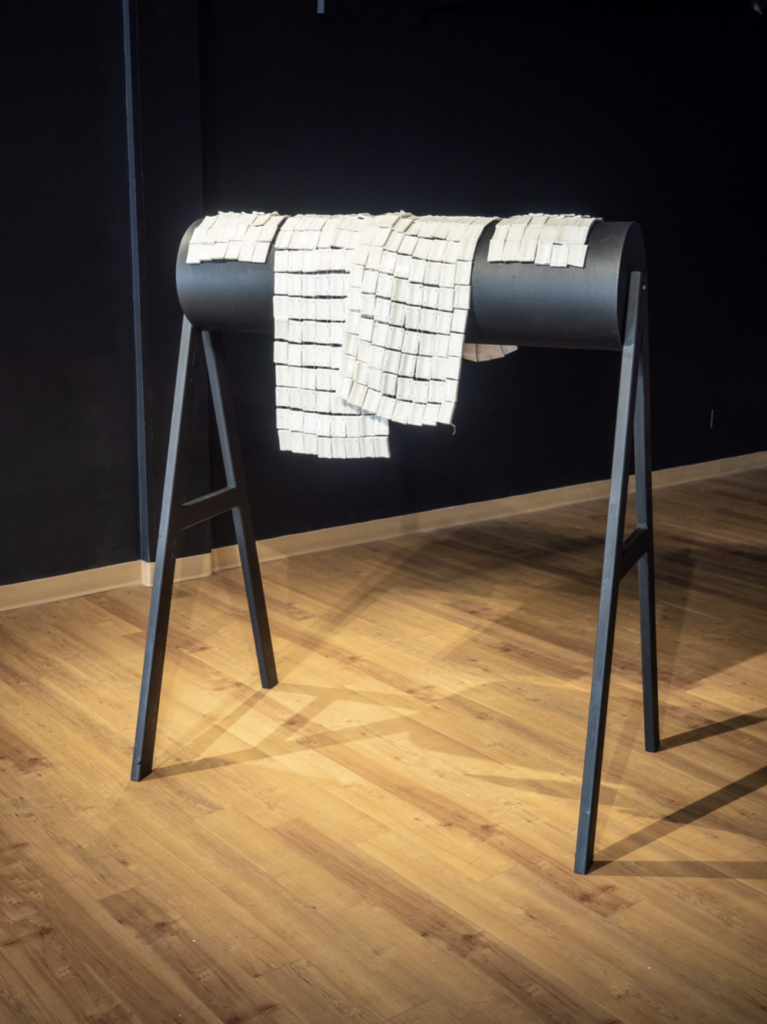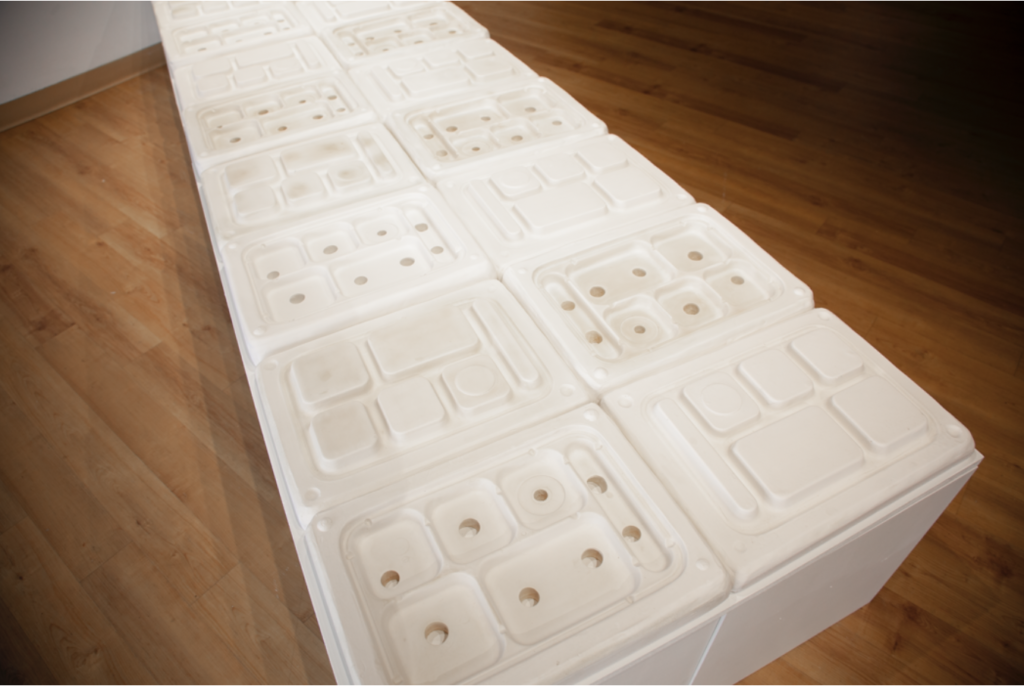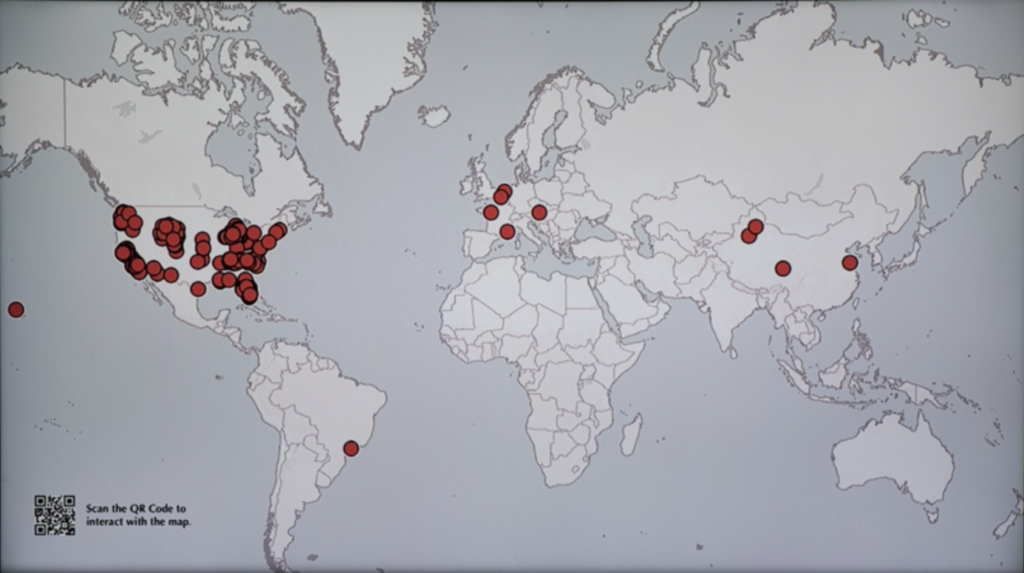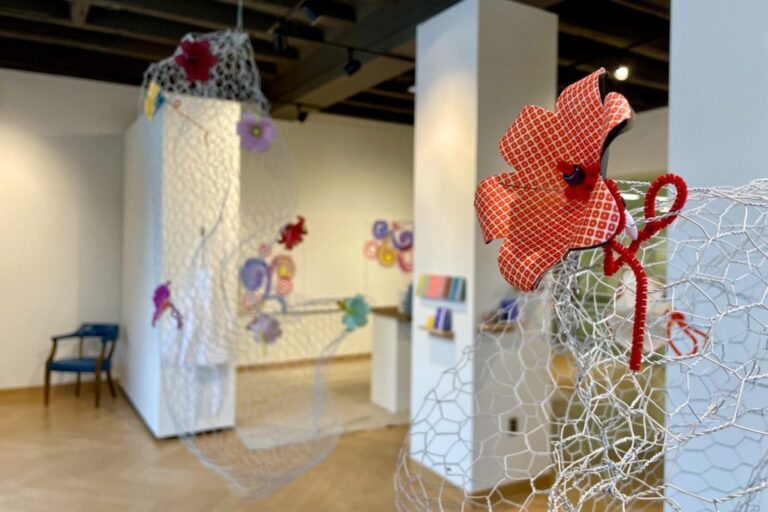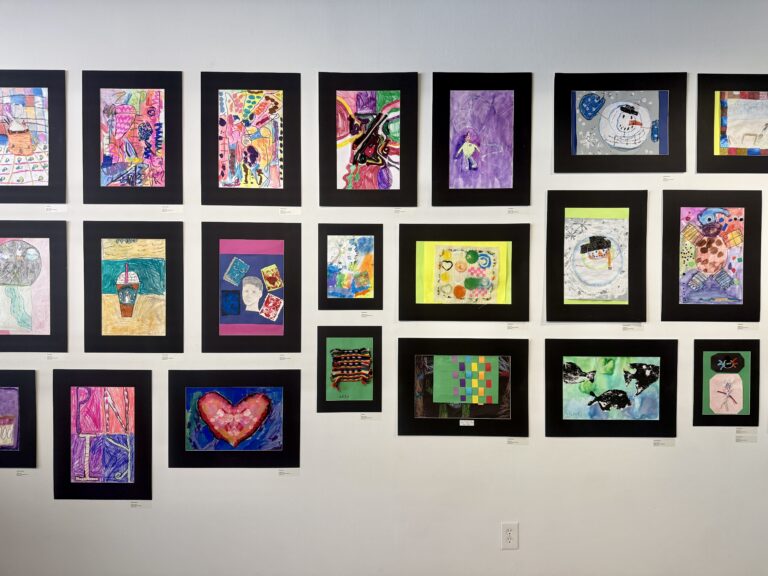Dan Paz
Artist-in-Residence: Critical Race Studies
March 3 – April 1, 2022
Closing Reception: April 1, 2022, 6:00-8:00 PM

As the global leader in mass incarceration, the United States warehouses (as of late 2020), 1.8 million people in jails and prisons across the country1; from county jails to Supermax prisons, architectural forms of temporal and spatial management, cutting-edge surveillance technologies, and the mechanization of prisoners’ labor have become central apparatuses in creating the conditions of life and death for people locked behind bars. While stories of exceptional violence within prisons erupt in mass media coverage from time to time, the banal and everyday forms of violence against incarcerated people largely escape the attention of those of us on the outside. It is difficult to imagine what the mundane biopolitical violence of the prison tastes like, smells like, feels like— perhaps it is difficult because so many of us on the outside simply do not wish to know or cannot bear to acknowledge.
Dan Paz’s long-term research and their unfolding body of work— the latest which has been made methodically and obsessively over the course of their time as the Critical Race Artist-in-Residence at Michigan State University— labors to manipulate and transform our collective perceptions of, as well as haptic orientations to, the prison industrial complex (PIC) in the United States. Their conceptual projects attend to the shifting and shifted conditions of mass incarceration, to consider how different modes of visually representing its ongoing violence might actually attune others to becoming better witnesses.
As a photographer by training and orientation, Paz has always been interested in the malleability and the weaponization of light. In The sun never knew how great it was until it struck the side of a building (2018), Paz investigated “how light is manipulated in carceral environments to craft a controlled collective space.” They concerned themselves with the architecture of prisons and jails, and in particular with the windows of the much-contested youth correctional facility in the Central District of Seattle— located only two blocks away from Paz’s then-home (and mine; we were neighbors living in the same apartment complex). Through high- and low-tech photographic experiments that included drone footage and cyanotypes (some of which were collectively produced with college-age volunteers and teenage members of the Seattle arts-based advocacy organization Creative Justice2), Paz offered an abolitionist vision of relationality that worked against these built architectures by recapturing access to light.
In this exhibition at MSU’s (SCENE) Metrospace Gallery, hammer without a nail, Paz jumps scale from the local Seattle context to the national, to wrestle with photographic processes writ large and with the organizing principles of carceral institutions across the United States. The parallel histories of photography as a medium and the development of the biopolitical prison industrial complex both tell stories about the desire to fix bodies in space and time (to create a non-blurry photograph; to produce a docile and reformed prisoner) and to standardize outcomes (to create multiple, identical photographic copies for mass circulation; to generate uniform industrial-standard goods using prison labor). Every piece in this exhibition is engaged in a sustained conversation with photography and the PIC, resulting in a challenging and nuanced constellation of objects that dreams towards the full abolition of the global carceral complex.

In 2020 I purchased and downloaded one of my father’s mugshots from a third-party criminal-search website for $29.99. My father died in 2009.
Operating at the scale of the body and the home, the most intimate piece in this exhibition is, unsurprisingly, a piece that resists capture. A copper-plate photogravure of a man’s mug shot rests on a wall, their face occluded due to Paz’s application of a “flash” of a faux camera. By obscuring the man’s verifiable identity, Paz performs a reparative act of removing the image from circulation; this is a loving, knowingly futile gesture, given the persistence of the unredacted digital mugshot on commercial websites such as mugshot dot com. While the refusal to reveal the complete image is a simple enough act to decode, what complicates matters is the personal story behind this image; for the “present-absence” is Paz’s deceased father, and the mug shot is/not his portrait.
Portrait photography since the 19th century has “allowed individuals to conceive of the nation as a collective, and also to place themselves visually within it”3, while the reproducible mug shot was developed to achieve the opposite effect: to suppress the agency the subject had by producing the evidence of criminality it purported to objectively capture4. Moving between the genres of family portraiture and mugshot in their material transformation of their father’s image from digital to photogravure and from visible to redacted, Paz does not allow viewers to see their father as a citizen or as a criminal. Instead, viewers, when looking directly at the copper plate, are met with a blank space or—if the ambient and artificial lighting hits a certain way— see their own face reflected back to them, as in a mirror. Finding one’s face superimposed on the photogravure, viewers are then faced with a choice about how to read this composite reflection. They can choose to see a portrait of themselves taking the place of the incarcerated subject of the mugshot, thus temporarily collapsing the distance between themselves as “free” and the other as “unfree.” Or they can refuse this intimate proximity to the other by looking away. Regardless of one’s ultimate response, this reworked photogravure remains a simultaneously personal and political impression of a father lost to the prison industrial complex; it is a haunting image that holds others accountable.

the seeing machine as 440,918,749 points – the view from the Ingham County Youth Detention Center, Lansing, Michigan
The cyclorama is the second piece in hammer without a nail that overtly engages with genealogies of photographic innovations and carceral surveillance technologies. In collaboration with artist Abraham Avnisan, Paz has produced a 360-degree Lidar-scanned image taken from the Ingham County Youth Detention Center located in Lansing. Visitors standing inside the cyclorama see a panoramic, panoptical vista of the outside of the prison from its center— it is an impossible viewpoint that is inaccessible in real time-space, both to those with ostensible control of the prison (the jailers) or to those captured within its walls (the youth).
In the late 1800s, co-temporal with the development of the modern US prison system, the cyclorama (or a circular “picture without boundaries” combining art, lighting, architecture, and installations) caught on as an early form of virtual reality, serving as educational and entertaining portals to exotic locales or the recent past for a public hungry for novel vistas and viewpoints5. Paintings of near-recent events were reinterpreted to shape the public’s grasp of historical narratives— Civil War cycloramas for and against the Union victory were especially popular and displayed in different regional locales from Boston to Atlanta6. Re-presenting the view from the youth detention center as an incredible 28-foot long cyclorama, Paz and Avnisan collapse the distance between past and present technologies of virtual reality; the cyclorama gives one a falsely omniscient viewpoint over the prison, which prison administrators and prison reformers both discursively believe that they have. Yet, by wresting control of sightlines for their own ends and by harnessing tech originally designed for the US military, Avnisan and Paz collaboratively perform a symbolic resistance to the PIC: they demonstrate the impossibility for any one person or entity to fully control an image’s production and circulation, and turn surveillance back onto the prison itself, so that the public may radically change their views on incarceration.
Standard Bath Towel, 20”x 40”
Standard Wash Cloth, 12” x 12”
Stacks for Andrea at Highland Elementary, 1978-84
Daughter Molds from the Mother Mold for Lunch Trays, 10 of 18
Overwhelming the gallery with the sheer force of multiplication, a series of sculptural interventions are the artist’s most difficult investigations into photography and the prison industrial complex; or more accurately, explorations into the desire to fix and control the body that both industries share. Imperfect copies of some of the most paradoxically intimate, mass-produced objects used by incarcerated people have been rearranged into uncanny monuments: stacks of fragile unglazed porcelain lunch trays rise as bleached obelisks, while hand-molded glazed replicas of Bob Barker’s soap have been strung into the exact dimensions of standard-issue prison hand and bath towels7. Nearby, Paz has arranged an installation of the plaster molds used to produce the (un)usable porcelain lunch trays: these irregular mother molds, like the other multiples, bear witness to the impossibility of perfect fidelity to the original object cast—an original which itself is but one of an endless copy generated through an assembly line. These sculptures are grotesque for their beauty: they are abstracted copies of mundane objects used daily by millions of people held in bondage in the nation’s jails and prisons, and even in K-12 schools8. While we might be tempted to fetishize these sculptures as mere art objects or decoration in a white cube gallery, however, the visible cracks and blemishes on their surface evidence the violence embedded into the conditions of their production.
Conceptually, the mass arrangements of these objects visually overcome the viewer akin to the ways their production physically overwhelmed their maker: Paz strained their body to the limit during the production process, in a futile attempt to control its outcome. Taking on the role of both the photographer desiring a perfect set of reproducible photographs, and the warden or administrator working towards a uniformly reformed incarcerated population, Paz’s body unwittingly performed the failure inherent to these structures, by breaking down and refusing to comply to the punishing work schedule they set for it. The objects generated by this brutal, time-consuming production process, too, resist perfection: the soap bars’ glazes have not stayed uniformly white, but have sometimes emerged as gray or yellow from the kilns; a number of the porcelain trays were cracked or broken, while some failed entirely to set, the slip too wet to hold the shape. The breaking down of all of these bodies— the body of the artist and the individual components of these larger sculptural installations— should generate an awareness in viewers that standardization and replication is an impossible and ruinous process. From this follows the question: why are prison reformers committed, then, to trying to fix systems that will always, inherently, be so broken?
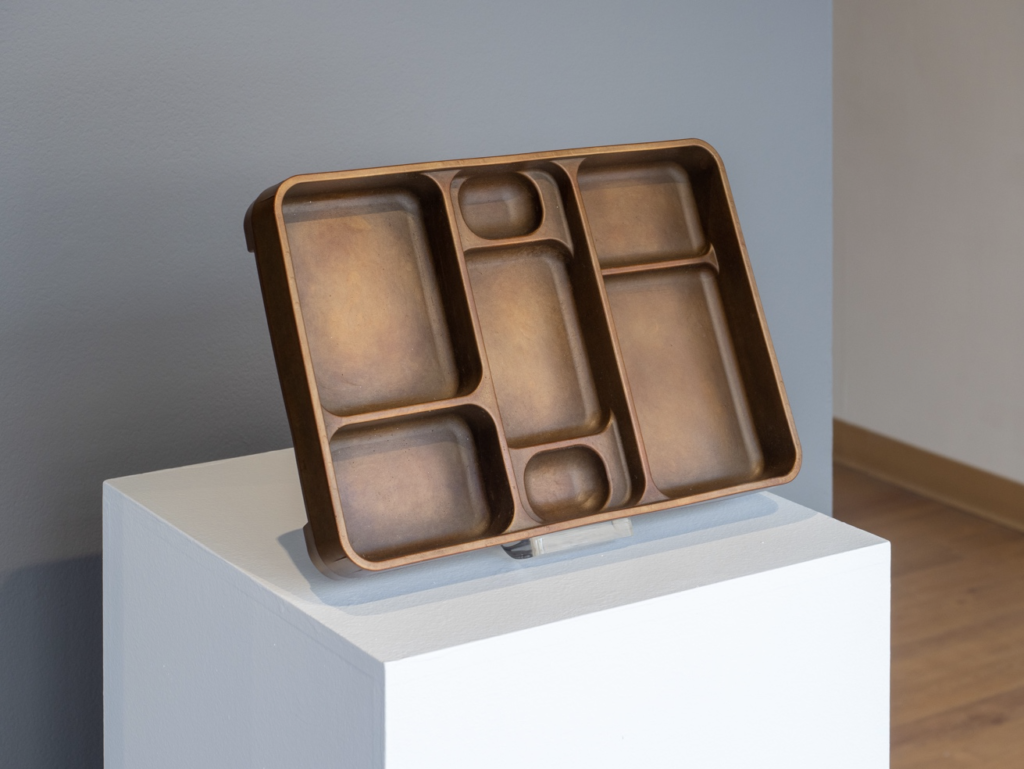
Supermax Food Tray, Tough, insulated, will not retain water, long-lasting to save replacement costs (lids sold separately), $214, Cortech
Two very different pieces round out this current exhibition’s meditation on incarceration: a singular bronze sculpture cast in the shape of a Supermax prison food tray, and an instructional video recording to direct gallery-goers to an interactive, collaboratively-produced and still-growing global map of youth detention centers and advocacy groups for system-impacted individuals and communities. These objects represent the two polarities of Paz’s investigative impulses, and together reflect the intertwined political and personal stakes for Paz in making this work.
The Supermax food tray is the heaviest single object in the gallery at 20 pounds, and illuminates the financial and ideological investments that US federal and state governments and private corporations have placed into the prison industrial complex— investments that far exceed the mere warehousing of millions of individuals deemed as surplus populations9. While lives are rendered disposable under the logics and practices of criminalization, more and more public and private money is invested in creating mass-produced goods (like food trays) to buy and sell to private and public prisons; meanwhile, incarcerated people themselves are forced to be part of that industrial supply chain as both producers and consumers10. As a facsimile with a difference, the solid bronze tray evinces the outsized valuation of mass incarceration as a solution to social crises in our collective popular and political imaginations— it is an excessive object specially cast for this exhibition, in the ways the actual food tray on which it is based has been uniquely manufactured to “save costs” for a growing industry that profits from millions of lost lives. This bronze tray, ultimately, serves as a material witness to the heavy role that incarceration has played in Paz’s family, their life story, and their professional trajectory. The prison industrial complex has shaped Paz’s practice as a solo artist profoundly, leading them to devote years of their life to making incarceration’s global and hyper-local impacts visible through photography, sculpture, and other mixed-media installations.
Youth Advocacy Map(s), 2018-present
Finally, the Youth Advocacy Map(s) grew from Paz’s recognition that art alone, and one individual artist alone, cannot dismantle the PIC. Their collaborative digital mapping workshops with students, activists, scholars, and artists in a growing number of cities across the globe is part of a tangible practice of world-making towards the full abolition of the prison industrial complex. By sharing their knowledge and skills in the digital humanities, Paz entices others near and far—from Lansing to Vienna— to participate in the creation of maps that not only show, but also generate, networks of mutual aid and resource exchange that benefit PIC-impacted individuals and communities: from legal service providers, to fundraising for bail funds, to transformative justice organizations doing direct action against prison expansion. The maps ask all of us who encounter it to do more than remain passive viewers— they call us to become active participants in the movement for prison abolition, and to imagine a world beyond reform.
Thea Quiray Tagle
February 2022
Bio: Thea Quiray Tagle, PhD is an independent curator, art writer, and assistant professor of ethnic studies and queer studies at the University of Massachusetts Boston. www.theaquiraytagle.com
[1] Statistics provided by Vera List Institute of Justice report, “People in Jail and Prison in 2020,” available to download in full here: https://www.vera.org/publications/people-in-jail-and-prison-in-2020
[2] Creative Justice: About Creative Justice. https://www.creativejusticenw.org/about-cj
[3] Shawn Michelle Smith, At the Edge of Sight: Photography and the Unseen. Durham, NC: Duke University Press, 2013. p. 167.
[4] Michelle Bogres, Documentary Photography Reconsidered: History, Theory, and Practice. New York: Bloomsbury Publishing, 2019. p. 292.
[5] Allison C. Meier, “Cycloramas: The Virtual Reality of the 19th Century,” JSTOR Daily, 2018. https://daily.jstor.org/cycloramas-the-virtual-reality-of-the-19th-century/
[6] Suzanne Wray, “A Tale of Two Survivors: The Gettysburg and Atlanta Cycloramas,” National Park Service, 2018. https://www.nps.gov/articles/000/a-tale-of-two-cycloramas.htm
[7] “Bob Barker Company has introduced many new, innovative products to help solve customers’ problems and make corrections and detention facilities safer. Bob Barker Company offers the broadest product line and largest inventory of corrections and detention supplies to federal, state, and local government agencies and select businesses.” https://www.bobbarker.com/
[8] Michigan Liberation is a grassroots abolitionist organization working on campaigns including #FreeGrace which push back against the school-to-prison pipeline. https://miliberation.org/
[9] For more on the modern prison state and the warehousing of surplus populations, begin with “Prisons and Class Warfare: An Interview with Ruth Wilson Gilmore” https://www.versobooks.com/blogs/3954-prisons-and-class-warfare-an-interview-with-ruth-wilson-gilmore
[10] For example: since 1947, California state license plates have been manufactured by inmates at Folsom State Prison, in a partnership between the state Department of Motor Vehicles and the CA Prison Industry Authority (CALPIA). https://catalog.calpia.ca.gov/services/license-plates/
The MSU Artist-in-Residence: Critical Race Studies is made possible thanks to generous support from the Michigan State University Federal Credit Union (MSUFCU), the MSU College of Arts and Letters, and the Department of Art, Art History, and Design.
We would like to gratefully thank Abraham Avnisan, Ariel Goldberg, Rebecca Casement, Alex Vonhof, Abbey Behan, Evan F. Christopherson, Jessie Gott, Michael McCune, Alex Nichols, Walt Peebles, Thea Quiray Tagle, Marissa Rubaiai, Jacquelynn Sullivan Gould, Katie White, Sean Pue, Francisco Villarruel, Marcy Mistrett, Caitlin Cavanagh, Alejandro Acierto, Megan Kudzia and Andrew Peterson at the Digital Scholarship Incubator at MSU, J.R. Campbell and Shannon Hines at the Design Innovation Hub at Kent State University, Karin Zitzewitz, and Amanda Tickner for their supporting roles. Additionally, we would like to recognize the work of Roger Smith of Michigan Art Castings in Leslie, Michigan for casting the bronze sculpture and Saper Galleries and Custom Framing in East Lansing, MI for framing the two-dimensional work in the exhibition.
Documentation by: Alex Nichols & Ryan Frederick
